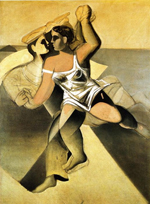
Eros
"Mr. Shiftlet felt that the rottenness of the world was about to engulf him" (183).
Flannery O'Connor's "The Life You Save May Be Your Own" (1953)
Points
for Reflection
EBB: "Bianca Among the Nightingales" (1862), 289-95
- do the figurative invocations of God and heaven by the narrator (ll.16-17) and Giulio (ll.21-22) successfully concretize and eternalize their love?
- why does the narrator twice observe that each man has but one soul (ll.39, 50)?
- why is the narrator currently in England instead of her native Italy?
- what exactly appears to have catalyzed Giulio’s shift in attention away from his Italian lover towards a new, English one?
- whom does the narrator blame more for her present circumstances, Giulio or his new lover?
- why does Barrett Browning close each stanza with “the nightingales”?
RB: "Mesmerism" (1855), 169-73
- the narrator, overjoyed by his newfound power, claims a kind of omnipotence for himself (ll. 1-4). What, exactly, does the narrator appear to want?
- consider the irony of line five.
- does the recurrence of "if" suggest that all this is an unrealized fantasy?
- the narrator imagines someone approaching him via "the garret-stairs" (l.14). If he lives in a garret, what does this suggest about his socioeconomic status, and likely occupation?
- does the narrator's application of mesmerism appear to require close proximity, or does it seem capable of traversing a great distance between himself and the woman he wishes over whom he wishes to exert mind control (ll.21-25)?
- does the narrator appear preoccupied with the desired woman's personality or person (i.e. body)?
- in what state does the narrator imagine "having" this woman? What do the words "Breathing and mute, / Passive and yet aware" (ll.33-34) suggest?
- does it matter that "to have and to hold" (l.31), a part of many wedding vows, is reversed in the subsequent stanza (l.36)?
- what verbs does the narrator use to describe possession of this desired woman (ll.35, 40)?
- what does the narrator suggest about the nature of his affection when he compares his mesmerizing power over the woman to the imprint made by the sun on paper coated with silver iodide (ll.41-45)?
- does the narrator consider the "veils" around the desired woman's soul as a series of doorways waiting/wanting to be opened, or as a kind of armor that needs to be penetrated (ll.46-50)?
- whose shape is being referenced in ll.52-55?
- consider closely the narrator's choice of language (verbage, similes, metaphors) used to describe the power dynamic between himself and the woman he desires (stanzas XI-XVI). Is this language romantic?
- why does the narrator describe the woman in question as "blind with sight" as she moves through the night to find him (l.85)?
- why does the narrator characterize this woman's mind as "still, composed, strong" (l.89)?
- recall question #11 (above). Whose shape is now being referenced in l.96? What of l.122?
- how would you answer the narrator's question of whether he has given life to this woman (ll.101-105)?
- who apparently utters the words, "Take me, for I am thine!" (l.115)?
- does the woman speak when she enter's the man's space (l.120)?
- why might Browning allow the narrator to describe his dream as a "shadow" (ll.124-25)?
- . to what end does the narrator pray in the closing stanzas (ll.126-35)?

Venus and Sailor (1925)
oil on canvas
Salvador Dalí
Dr. Paul Marchbanks
pmarchba@calpoly.edu
![]()
